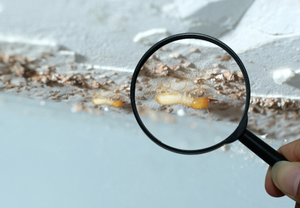There is no arguing with the fact that termites cause significant damage to homes in the US every year. In fact, the cost to repair termite damage adds up to more than the cost of repairing damage from natural disasters. Termites are a serious problem. One of the scariest aspects of termites is that they can eat away at the wood of your home silently. You could go for months and months with an active termite infestation and never suspect anything. It is common for homeowners to realize they have termites only after there is widespread damage. You do not have to fall into that category! There are ways to determine if you have termites so you can take proactive steps against them. Termite control is something that no home or business owner wants to have to deal with. It’s quite common for people to be unaware that they have a termite problem until the termites have already caused a significant amount of damage. Each year, termites invade millions of homes, causing billions of dollars in damage that’s not covered by homeowners insurance. While they’re found in every state except Alaska, termites are a significant threat in San Diego County. It’s not a matter of if your home will encounter termites but when making termite control a necessity.
Where do I look for termites?
There are two main types of termites that cause problems for homeowners in San Diego County: subterranean termites and Drywood termites. Both types of termites will damage wood but there are some important differences between them. While not the most common species in Southern California the subterranean termite destroy homes at a rate of almost 80 times that of the Drywood termites. As the name implies, they generally enter homes from below. Subterranean termite colonies are much larger and better organized, which enables them to affect much greater damage in less time. The majority of subterranean termites are actually members of a “worker caste,” and their sole job is to eat away at your home 24 hours a day. Drywood termite on the other hand is very prevalent in San Diego County. They are social insects that infest dry wood and do not require contact with the soil. Light brown with narrow, oval-shaped bodies, Drywood termites typically shed their veiny wings within minutes of landing, leaving them behind as evidence of an infestation. Most people report seeing discarded wings of flying (swarming) Drywood termites. They may be found in windowsills, in and around light fixtures, in the attic, or in similar places where swarmers can exit a colony. Drywood termite colonies range in number from a few dozen to up to 3,000. Drywood termites love to infest dry wood and are commonly found in the wood framing of attics. Winged reproductive Drywood termites usually emerge from an existing colony in Late August to September to scout for new locations.
What are the signs of termite activity?
Subterranean termites create mud tubes to travel back and forth from their colony to their food source. These mud tubes, a mixture of dirt or sand) can look brown, yellow, or tan in color and often resemble a winding road. Mud tubes are small but are relatively easy to spot if you know what to look for. Drywood termites can leave behind piles of excrement – called frass – that resemble piles of sawdust. The other sign of termite activity – the one you want to avoid – is damaged wood. There are several potential causes for damaged wood other than termites. It is important to determine if there is termite activity as soon as you noticed damaged wood because termites will continue to cause damage until you take action.
Should I get professional help looking for termites?
The best way to truly understand the depth of a termite problem is to call a termite control expert. It can be difficult to accurately identify the signs of termite activity. If you have any reason to suspect a termite infestation in your home, get help right away. These pests will not stop causing damage to your home until you eliminate them completely. Nixtermite provides free home inspections.* We’re proud to provide termite control solutions for our neighbors throughout San Diego and San Diego County.
*There is a nominal fee for escrow reports.



